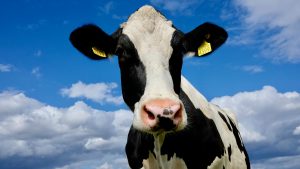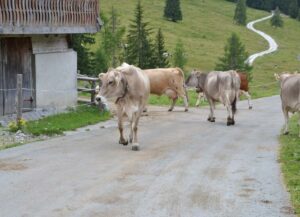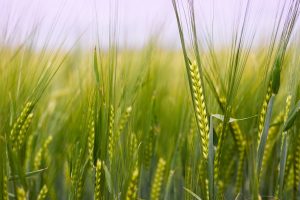Maria Villagrasa & Fernando Diaz
Grazing has economic, health and animal welfare advantages when compared to breeding in total confinement. However, it is necessary to know and treat each plant species adequately to make the most of it. One of the most used pasture species for grazing is alfalfa, particularly in temperate climates.
Alfalfa has on average 8% pectins, 10% hemicellulose, 25% cellulose and between 7-8% lignin. Therefore, it ensures a rapid transit through the digestive tract, a significant supply of soluble fiber and high buffering capacity. It is a good source of macro minerals, especially calcium, chlorine and potassium. Its content in microminerals (manganese, zinc), vitamins (E, D, biotin and provitamin A), and pigments is also high.
The magnitude of the cow’s productive response to alfalfa depends on factors such as number of grazing animals, the alfalfa variety, the intensity and frequency of defoliation, etc. A study (Lemus V. et al, 2020) conducted in Mexico, evaluated which factors influenced alfalfa production for grazing and milk yield in a group of cows that grazed alfalfa for three years under different management regimes.
The pasture was established in 2005 with Dactylis glomerata (orchard grass), Lolium multiflorum (Italian ryegrass), Festuca arudinacea (festuca), Bromus inermis (smooth brome), and Medicago sativa (alfalfa), which by 2009, was the dominant species.
The offered pasture sward (kg DM/ha) was estimated as the existing biomass in the pre-grazed pasture, and the residual biomass post-grazing. The recovery time between defoliations (in days) was recorded for each grazing period. The rate of accumulation of pasture was calculated as the grass mass offered divided by the recovery time.
The cows were always kept grazing and consumed supplements offered in a pen before milking. The supplement was a commercial concentrate consisting of 1.8 kg of rolled corn grain and 1.6 kg of prairie hay per day.
In the three years studied, the average effective area for grazing was 12.4, 17.8 and 22.2 ha and the animal density 3.63, 3.03 and 2.75 cows/ha year. The level of utilization of the pasture was 75, 71 and 73 %.
Alfalfa production
From 2009 to 2011, the grazing area was growing and the level of supplementation decreasing, which resulted in a DM production of: 17.3, 14.7 and 13.5 kg DM/ha day.
There was a relationship observed between the rate of accumulation and rate of growth of pasture. The rate of accumulation of pasture showed a seasonal behavior with greater accumulation in the summer (82.6 kg DM/ha day) and less from November to February (28.5 kg/ha day).
The growing season lasted 173 days (from mid-April to mid-October) and the rate of pasture accumulation was lower than average for 192 days (or a few more days than the length of the growth season). It is during this period that the growth rate of alfalfa cultivation and livestock supplementation would have to be improved to reduce feed shortages.
As for the residual pasture mass these was significantly low from December to February and much higher from June to August (on average 296.6 kg/ha and 668.0 kg/ha). The same thing happened with the pasture mass offered which was highest from June to August (2,347.3 kg/ha).
A relationship was also observed between the residual pasture of the previous month and the grass offered, albeit differently depending on the time of the year. This pattern of alfalfa production, especially from November to February, suggests that there is the potential to obtain a higher biomass to offer with a residual pasture mass between 400-600 kg of DM/ha to maximize the rate of accumulation of alfalfa for the next grazing cycle. Moreover, the smaller the residual mass post-grazing, the less metabolizable energy will be obtained from pasture, so it is important to compensate with the addition of supplementary feed.
Regarding the nutrient composition of alfalfa, the energy concentration was particularly high in the Fall (1.13 Mcal/kg DM). The DM content was higher in Spring (25.9%) than in Fall (22.0%). A significant correlation was found between the pasture mass offered and protein, so that protein concentrations were high from Fall to Winter, with higher concentrations from November to February (22.4%) than the rest of the year (21.9%). The concentration of neutral detergent fiber was 46.9% in Spring and 44.3% in the Fall, with ash concentration at 3.6% in Spring and 3.1% in the Fall.
Milk production
Cows in lactation were incorporated seasonally: the largest number from June to August and the smallest, from December to January. Milk production per hectare was related to the number of cows in lactation: milk production per cow was lower in September to November (13.1 kg/cow day) compared to the other months of the year (16.5 kg/cow day).
Milk production parameters over the three years were influenced by environmental, pasture and feed composition variables. It was observed that daytime temperatures, monthly energy intake from pasture and monthly energy intake of concentrate explained variability in milk production (19,290, 13,419 and 12,563 kg/ha year), total solids (2,409, 1,638 and 1,554 kg/ha year) and fat (727, 523 and 496 kg/ha year).
These results are consistent with the use of pasture: in 2009 pasture use was lower thanks to the high concentrate availability that year. However, in 2010 and 2011, in the absence of enough concentrates, increasing the use of pasture showed a negative effect on production. It is believed that a grass mass offered above 2,000 kg/ha and a residual pasture mass at 600kg/ha would find a balance between animal and pasture production.
Conclusions
The mismatches in pasture production and milk yield peaks were notable, indicating the need to better synchronize the annual phases in this grazing system.
Feed supplementation is necessary in cattle that graze with alfalfa and should be applied strategically during certain parts of the year, considering the objective of total production of milk solids.
Reference
Vicente Lemus Ramírez, Aurelio Guevara Escobar, Juan Antonio García Rodríguez, Delia Gaspar Sánchez, José Guadalupe García Muñiz, David Pacheco Ríos. Milk production in dairy cows grazing alfalfa (Medicago sativa) in the central Mexican highlands. Rev Mex Cienc Pecu 2020;11(1):1-18.
© 2020 Dairy Knowledge Center. All Rights Reserved.











